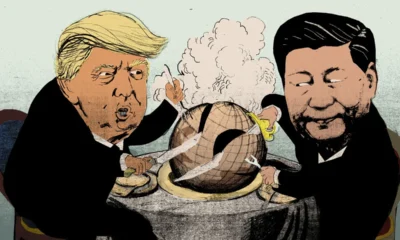Markets
Why HSBC Downgraded India To ‘Neutral’. What Are The Implications For Markets And Retail Investors Going Forward?
Published
9 months agoon

HSBC has adjusted its outlook on Indian equities, downgrading the country to ‘Neutral’ from ‘Overweight.’ The firm has also set a Sensex target of ₹85,990 for 2025, citing a slowdown in corporate profit growth and elevated valuations as key concerns.
The Downgrade Explained
While India’s equity markets have enjoyed an impressive annualized growth rate of 25% in recent years, HSBC believes this pace is unsustainable. The firm has sharply reduced its FY25 earnings growth projection for the Nifty 50 to 5%, down from the earlier estimate of 15%. This revision reflects immediate profitability challenges for Indian companies, particularly in light of current valuation metrics.
With forward earnings multiples at 23 times, HSBC considers Indian markets overvalued, especially when coupled with muted earnings expectations. This recalibration could lead investors to reconsider their positions in Indian equities, potentially impacting market inflows and performance in the short term.
Retail Investors Remain Resilient
Despite HSBC’s cautious stance and the prevailing market volatility, retail investors in India are showing remarkable maturity. A growing preference for the “buy on dips” strategy and increased allocations through Systematic Investment Plans (SIPs) indicate that investors are leveraging market corrections as opportunities.
Between December 2022 and November 2024, while the Sensex and Nifty posted negative closes in 14 of 36 months, SIP inflows grew in over 71% of those months. For instance:
September 2022: Sensex declined 3.54%, yet SIP collections rose to ₹12,976 crore from ₹12,693 crore in August.
October 2024: Markets fell around 6%, but SIP inflows climbed to ₹25,323 crore from ₹24,509 crore the previous month.
)
Evolving Retail Investment Behavior
Experts agree that retail investors have evolved, shifting from reactive trading to strategic investing. Juzer Gabajiwala, Director at Ventura Securities, notes that investors now base their expectations on long-term horizons, reducing the impact of short-term market volatility.
Pranav Haldea, Managing Director at Prime Database, echoes this sentiment, emphasizing that retail investors have moved away from the “buy high, sell low” pattern. Instead, they are capitalizing on market corrections to bolster their mutual fund investments.
Aditya Birla Sun Life AMC’s market outlook report further suggests this trend. Of 20 market corrections between 2016 and 2024, 17 saw SIP flows exceed the prior 12-month average. While direct retail ownership in BSE500 stocks has declined, mutual fund inflows have surged, with SIP annualization now at $35 billion.
A Shift in Household Investment Strategies
Indian households are increasingly opportunistic, reallocating capital to equities during periods of market volatility. This shift has significantly boosted mutual fund investments, with domestic institutional investor (DII) participation now at 15.8%.
Harish Krishnan, Co-Head of Equity at Aditya Birla Sun Life AMC, illustrates this transition:
“Investors are leveraging market volatility to increase their equity exposure, focusing on both direct equities and mutual funds.”
Understanding Market Cycles
Investors have also developed a nuanced understanding of market cycles. Declines are shorter and recoveries quicker than in the past, reducing the duration of bearish periods. Gabajiwala explains, “Now you see 2-3 months down, followed by 2-3 months up, unlike earlier extended bearish cycles.”
Indian Stock Markets Outlook
Despite the slip in HSBC ratings, the Indian stock market outlook remains positive, supported by strong macroeconomic fundamentals. Key drivers include improving terms of trade, flexible inflation targeting, and a conducive environment for private investments. Analysts anticipate strong earnings growth in the coming years, underpinned by an emerging private capital expenditure (capex) cycle, re-leveraging of corporate balance sheets, and a structural rise in discretionary consumption.
Factors Supporting Market Growth
- Macroeconomic Stability:
Continued fiscal consolidation, high real GDP growth, and relatively lower real interest rates are expected to sustain India’s economic stability. - Domestic Growth and Global Tailwinds:
- Strong domestic demand and a structural shift toward private investment are bolstering growth prospects.
- A potential absence of recession in the US, benign oil prices, and ample domestic risk capital further strengthen this outlook.
- Earnings Momentum:
Earnings growth is forecasted to remain robust, driven by favorable economic policies and a renewed capex cycle.
Market Performance and Trends
In December, Indian markets displayed resilience amidst global volatility. While large-cap indices like Nifty and Sensex dipped by 2%, midcaps gained 1%, and small caps held steady. Comparatively, US midcaps and small caps faced sharper declines of 7% and 8%, respectively, reflecting a global risk-off sentiment.
This divergence can be partly attributed to foreign institutional investors (FIIs) engaging in tax-loss harvesting and reassessing asset allocations. Rising US Treasury yields and inflows into money market funds suggest a shift toward defensive strategies.
Positive Indicators for the Indian Economy
- GDP Growth:
Real GDP is projected to close FY2025 at 6.4%, with nominal GDP growth expected to range between 11.5% and 12%. - GST and Tax Collections:
GST collections rose by 9.1% year-on-year between April and December 2024, while advance tax collections surged by 21% in the same period, reflecting strong economic activity. - Corporate Performance:
Listed companies are expected to outpace nominal GDP growth, benefiting from the underrepresentation of the slower-growing agriculture sector in the equity market.

Policy and Budget Expectations
The upcoming Union Budget for FY2025-26 is likely to emphasize capital expenditure, with a projected increase of 12% or more. Meanwhile, the Reserve Bank of India (RBI) is anticipated to reduce interest rates in February, aligning with the Federal Reserve’s recent rate cuts. These measures are expected to further support growth and market sentiment.
Valuation Insights
- Large-Cap Opportunity:
Large-cap stocks, trading at a PE of 22, appear undervalued relative to midcaps (PE=43) and small caps (PE=34). - Sectoral Analysis:
Banks and Financial Services, Auto, Metals, and Oil & Gas sectors trade below the Nifty 50 average PE. However, cyclical sectors like Metals and Oil & Gas may be fairly valued, making Banks the most attractive large sector currently.
Growth Projections
With expected revenue and earnings growth of 15%-16% in 2025, coupled with potential RBI rate cuts and renewed FII inflows, Indian markets are poised for a re-rating. Analysts foresee PE multiples reaching 25 or higher, indicating significant upside potential for investors.
The Last Bit
India’s equity market remains a compelling investment destination, backed by strong domestic fundamentals and favorable global conditions. While short-term volatility persists, the long-term outlook is promising, driven by robust macroeconomic stability, policy support, and sustained earnings growth.
While HSBC’s downgrade may prompt caution among global investors, retail investors in India remain undeterred, leveraging market corrections to strengthen their portfolios. As Indian markets manage profitability challenges and valuation concerns, the resilience and strategic behavior of retail investors could serve as a stabilizing force in the evolving investment ecosystem.
You may like
-


Indian Stock Markets In Meltdown Mode—Is It Time To Buy The Dip? Gold Is On Fire, And There’s No Stopping It!
-


China’s Comeback And Trump’s Bullseye Have Cracked The Nifty And How—As Global Investors Eye Other Shores!
-


The Slippery Slope Of One More Drop. Nifty Nearing Its 28-Year Record-Breaking Crash. Is Zomato And Jio Fin To Be Blamed?
-


Are Indian Startups Foundations Cracking As Funds Start Moving Out And Away? The Road Ahead, Dance Without Music?
-


Indian Stock Markets’ Downward Spiral Continues, Sensex Down 3,000 Points In Over A Week! The Big Guns Lose Rs 81,000 Crore—Will The Mayhem Stop?
-


Singapore Economy On A High. Annual GDP Expands At Fastest Pace Since 2021. Asian Markets Mixed Bag Reaction To Trump’s Reciprocal Tariffs
